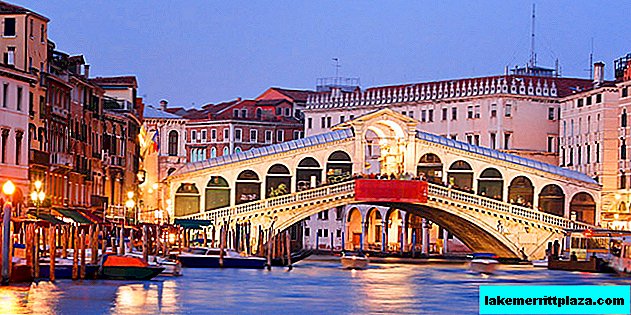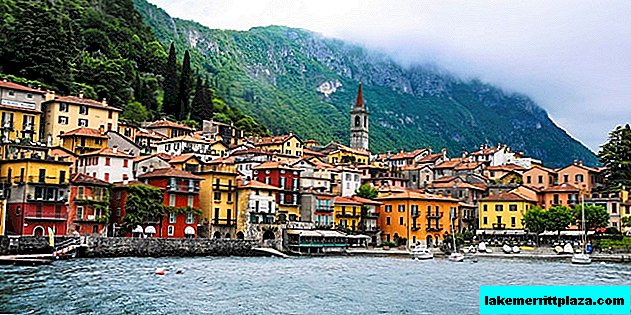Some Italian dishes quite firmly woven into the outline of the cuisines of many countries. Which, unfortunately, cannot be said about Gnocchi. Despite a long history, they are only beginning to gain popularity outside their homeland. This is a kind of dumpling from Italy. As with many dishes of the republic, gnocchi recipes differ significantly from region to region. The culinary traditions of different countries of the world also have their analogues. Our article will help you understand the difficult world of such simple flour products.
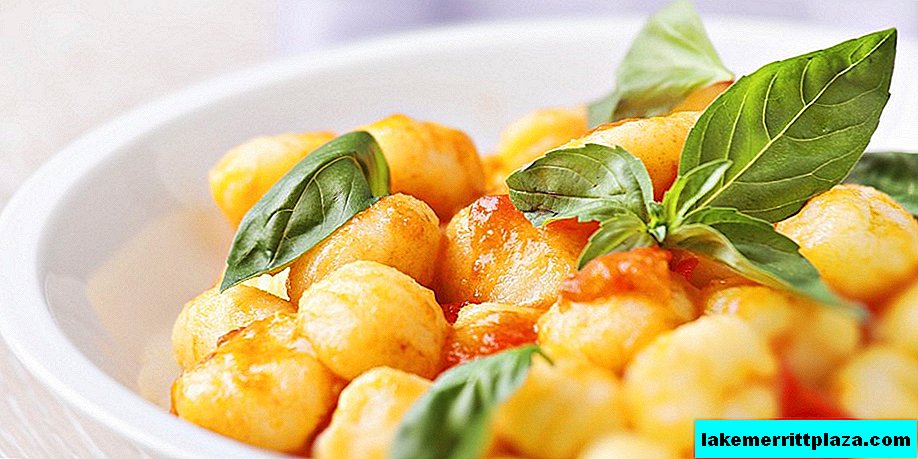
Story
Gnocchi has rather deep roots that date back to the 16th century, the period in which the import of potatoes from America began. However, the potato version of the dish is just an evolution of a much older Italian recipe dating back to 1300.
In fact, the very first gnocchi were called "zanzarelli". Their base was not potatoes or semolina, but grated stale bread. It was mixed with dried fruits and milk and molded balls.
In the XVII century, despite the fact that potatoes were already widespread in Italy, gnocchi from this root crop had not yet gained due popularity. In most regions, crushed crackers in the recipe were replaced with flour, and milk with water and eggs. This dish was called "malfatti".
The first documented recipe for potato gnocchi dates back to the second half of the 18th century. And since the end of the 19th century, the popularity of food has spread throughout the country with the speed of a fire. The term "gnocchi" was derived either from the Italian nocchio, meaning "a knot on a tree," or from nocca (knuckle). Probably the name is associated with the form.
It should be noted that the size of Italian dumplings has changed over time. From the size of a chicken egg, they came to small "shells" for one bite. This decrease necessitated a better impregnation of the dough with the accompanying sauce.
Varieties by region
There are many options for gnocchi. But, nevertheless, they have common characteristics to fit into one group of products. Let's see which dumplings are eaten in different regions of Italy.
Puglia
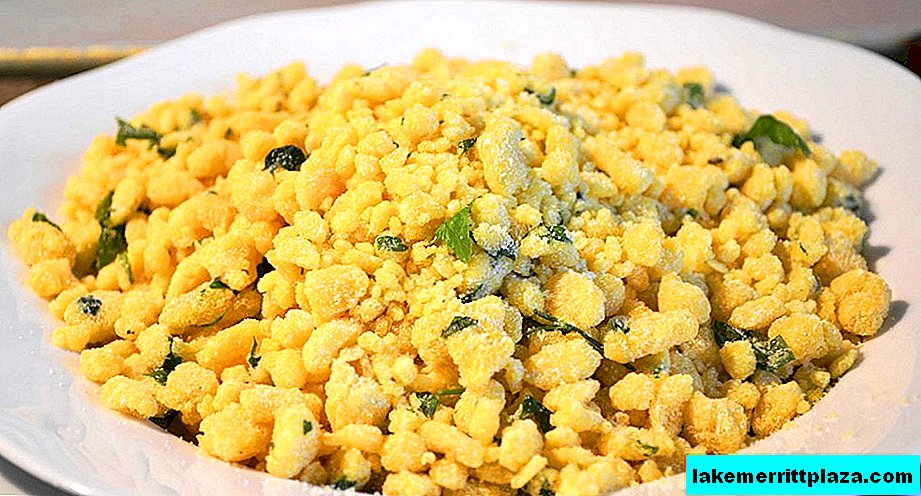
Gnocchi from Puglia (Puglia) are called Triddhi. These are small pieces of dough made from semolina, grated cheese, eggs and parsley. They are boiled in meat broth and eaten for Christmas or Easter.
Valle d'Aosta and Piedmont
Residents of Piedmont (Piemonte) and Valle d'Aosta (Valle d'Aosta) prefer the so-called dunderet or strangoiapreve. They are a mixture of flour, potatoes, eggs and milk. They have a different shape, but more often look like small, elongated “fingers”.
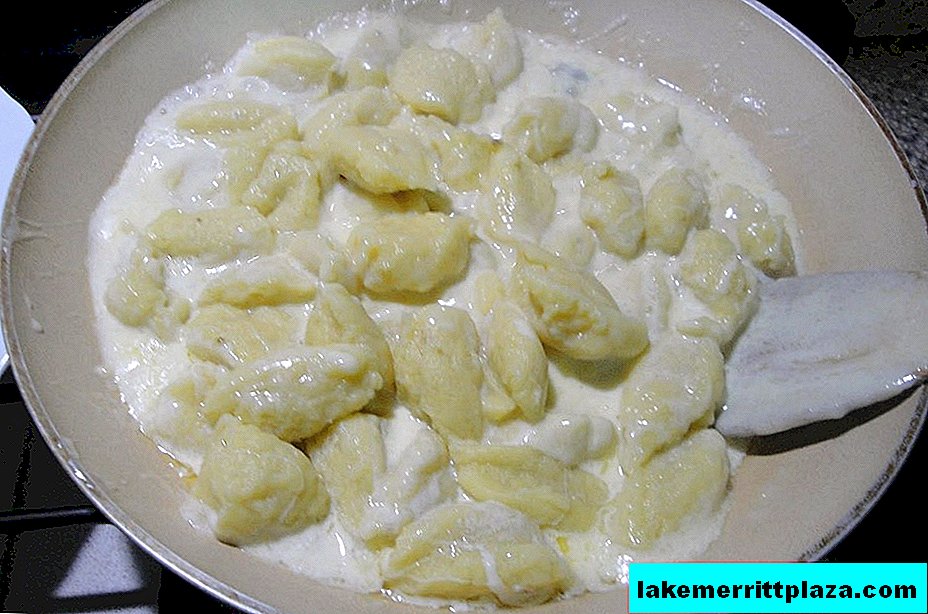
Val Varaita is another type of potato gnocchi characteristic of the Castelmagno municipality. The dough for them is prepared with the inclusion of cheese Tom (Tomino). Serve generously flavored with butter and grated cheese.
Veneto
Italians from Veneto (Veneto) adhere to classical preferences. Potato gnocchi usually accompanies pastissada, a traditional Venetian stew of horse meat.
The menu of the region's restaurants includes a version of gnochi con la fioreta - ricotta mixed with flour and eggs. They are boiled and served with butter and cheese.
During the carnival on the streets of Venice you can meet a funny character - Papà del Gnoco. This is a gray-bearded old man, dressed in a red-white outfit with a mantle. In his hands flaunts a large fork with a gnoc strung on it.
Campaign
Gnocchi alla sorrentina (Gnocchi alla sorrentina) - represent the cuisine of Campania. In fact, these are potato dumplings seasoned with a characteristic sauce. It consists of tomato paste, garlic, olive oil, basil and cheese fior di latte (fior di latte).
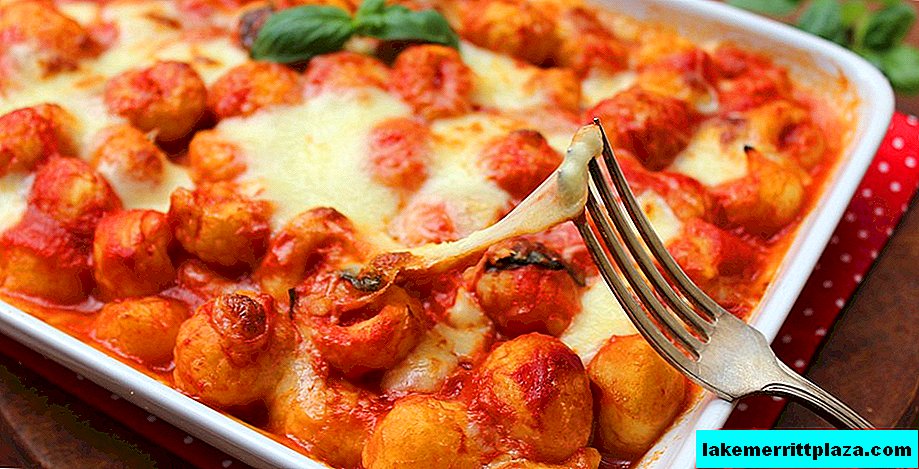
Lazio
The undisputed leader among dumplings in the Lazio region is considered gnocchi alla romana (gnocchi alla romana). They are made on the basis of semolina, milk, butter, eggs and parmesan. The cylinder-shaped dough is cut into medallions, which are baked in the oven, and not boiled.
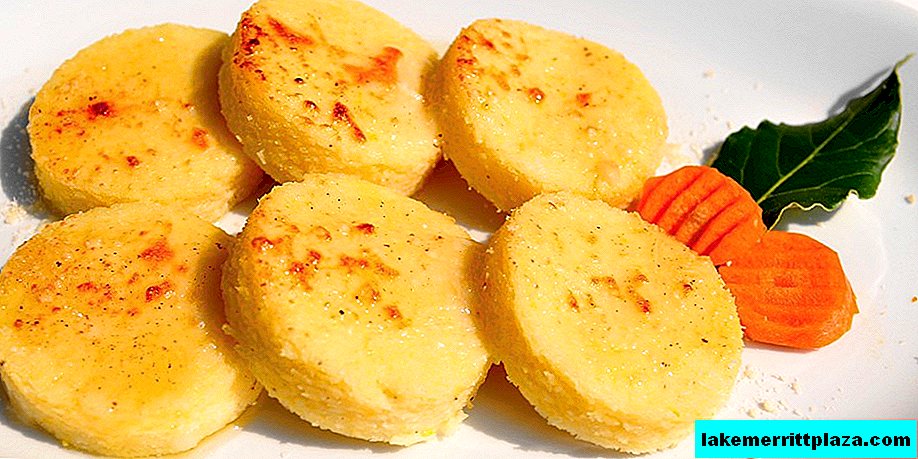
In the Amatrice area, gnocchi ricci are popular. They owe their name to their shape, which is obtained by flattening a piece of dough between the thumb and forefinger. The classic way of serving food is in combination with lamb stew and pecorino cheese.
Lombardy
Pawnshops do not have a special love for potatoes, so spinach and various herbs are more common in their gnocchi. Although in some recipes there is a small amount of mashed potatoes from the American root crop.
One of the variants of the northern dumplings is called malfatti. This is a mixture of spinach with eggs and chopped breadcrumbs. Ideally, they need to “rest” the night before cooking, but the most impatient ones cook them immediately, seasoning them with plenty of butter and grated parmesan before serving.
In the commune of Gera Lario (Gera Lario) there is a recipe called gnocchi alla lariana (gnocchi alla lariana). Their dough includes flour, eggs, milk and herbs. The finished dish is served with fresh cheese, tomato or meat sauce.
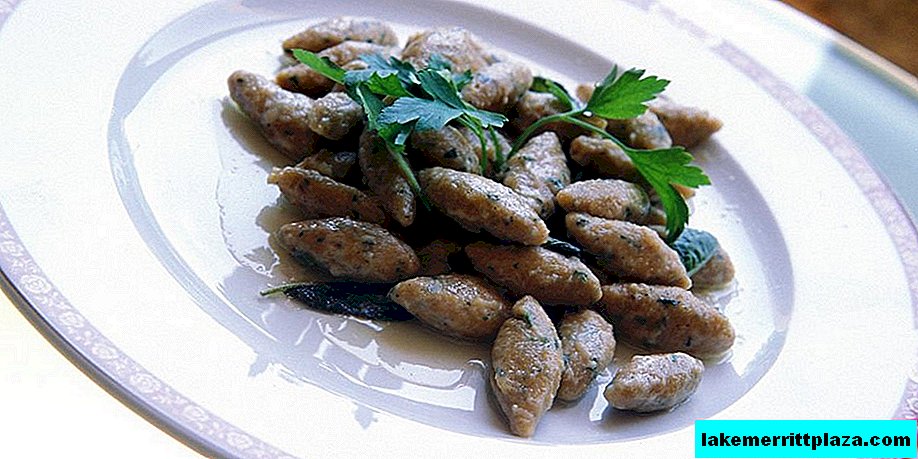
In Mantova (Mantova) are popular capunsei (capunsei) - a dish of peasant origin. They are small sticks with tapered ends. They are made from grated crackers, Gran Padano cheese, ghee and eggs. As seasonings use nutmeg, cloves and garlic. Served cooked kapunsei with various accompaniments: butter with sage, tomatoes, salami or lamb with herbs.
A few more types of gnocchi are characteristic for different cities of Lombardy:
- Polentoni - dumplings from the remains of polenta mixed with flour and eggs;
- Gnòc de schelt - gnocchi with the addition of chestnut flour;
- Gnòc de rìh - ball-shaped rice dumplings;
- Gnocchi di zucca - pumpkin version of the dish. Serve it with butter and cheese.
Marche and Umbria
Gnocchi di Apecchio (Gnocchi di Apecchio) - a dish representing the cuisine of Marche (Marche). In their test, in addition to wheat, there is cornmeal.
In Umbria, gnocchetti alla collescipolana is preferred. To prepare them, knead the flour with crushed crackers and water. The traditional sauce accompanying the meal contains sausages, beans and tomatoes.
Sardinia and Sicily

Sardinia (Sardegna) is the birthplace of malloreddus. This is a kind of hybrid of gnocchi and pasta. Small pieces of dough in the form of shells are traditionally served together with a sauce of tomatoes, salsichchi, saffron and pecorino cheese.
Sicilian dumplings called ganeffe are a smart way to recycle the remnants of rice. It is boiled and mixed with oil, egg yolks, parmesan and saffron. Balls are formed from dough, which are first fried in olive oil, and then served in separately cooked meat broth.
Tuscany
The pride of Tuscany (Toscana), in particular the area of Siena (Siena) and Grosseto (Grosseto), are nyudi (gnudi). To prepare them, ricotta is mixed with spinach and roll in flour. They are boiled and served with melted butter and herbs. Nyudi is the advantage of home-made meals, so they are rarely found on sale.

Tuscan housewives also make Gnocchi del cicolano (gnocchi with corn and wheat flour) and matuffi. The latter are polenta of dumplings, alternating with layers of meat or mushrooms with parmesan.
Trentino Alto Adige
Canederli is a favorite of the Trentino region. These are balls of crackers, milk, onions, and parsley. Sometimes they are enriched with speck and cheese. Usually they are served in meat broth with butter and grated hard cheese. They also act as an accompaniment to goulash.
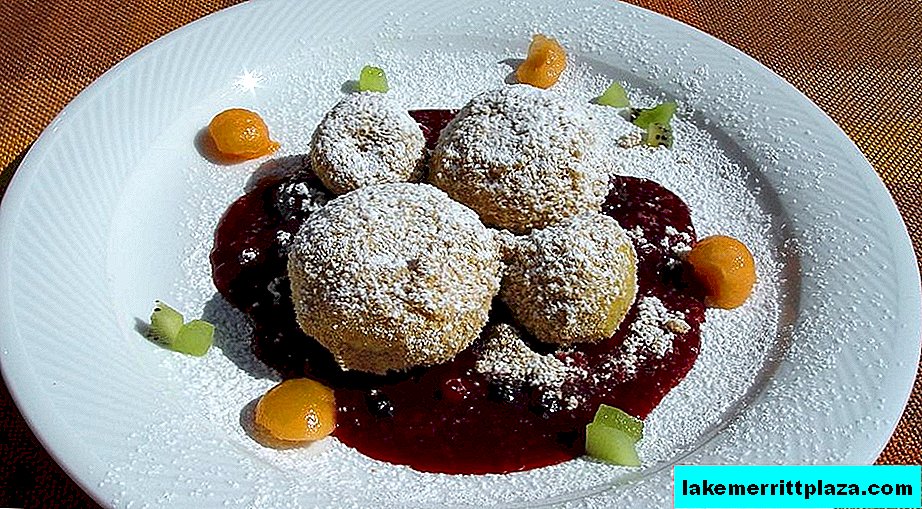
Do not forget about the sweet versions of the food. Canederli d'albicocche (dumplings with apricot) and di prugne (with prunes). After cooking, they are fried with butter, sugar and cinnamon until a caramel crust is formed. They eat both the first dish, and as a dessert.
Friuli-Venezia Giulia
The Friuli region is characterized by an unusual variant - gnocchi de susini (gnocchi de susini). This is a prune in a "shell" of potato mix. At the same time, they eat such a version as the first dish.

In Trieste, Gnocchi de gries friulani is preferred. Prepare them from semolina and eggs. Served in broth or with melted butter.
Emilia Romagna
In Emilia-Romagna, the dish pisarei e faśö, which came from the Middle Ages, is widespread. They are based on dough made from flour and breadcrumbs, rolled into long cylinders, cut into small pieces the size of beans and crushed by the thumb. They are served with beans, lard, onions and tomato.
Another popular variant of malfatti di Borgotaro gnocchi is a combination of ricotta, flour and herbs (or spinach).
Classic recipe
Despite the fact that the first gnocchi appeared long before the American root crop was imported into Italy, still recognized as a classic potato recipe. These soft dumplings blend perfectly with any sauce. To prepare them, we need very few ingredients:
- Potato - 1 kg;
- Flour - 300 g4
- Egg - 1 pc.;
- Salt is a pinch.
To begin with, carefully wash the potatoes, pour them with cold water in a large pan and put on fire. From the moment the water boils, cook for 30-40 minutes, depending on the size of the root crop. We check the readiness with a fork: if the teeth have passed to the middle gently, then you can turn off the heat and drain the water.
On the working surface, spread the flour in a pot. We peel the hot potatoes, rub on a fine grater and send it to flour. Pour a slightly beaten egg with a pinch of salt into the deepening of the resulting “structure”.
Mix everything with your hands until the dough is soft and compact. Too long kneading of the dough can lead to the fact that the finished gnocchi will be harsh.
We take a small piece of dough and with our hands we form a sausage about 2 cm thick. When working with one part, the rest of the mass must be covered with a towel in order to avoid airing. We cut the sausage into pieces 2-2.5 cm long and use a fork to make ribs on each dumpling to give a classic shape. Sprinkling with dough semolina or flour will help to prevent the dough from sticking to your hands and work surface.

Dip the pieces in boiling salted water. As soon as they surface, our potato gnocchi are completely ready. Serve with sauce to taste.
In order to preserve the semi-finished product, we lay out the raw dumplings on a tray sprinkled with flour at a small distance from each other. Sent to the freezer for 20 minutes. Then we transfer the package and freeze again.
Recommendations
A fairly simple recipe still has several "pitfalls", stumbling upon which, you can significantly spoil the dish. Simple recommendations will help you avoid trouble:
- When choosing potatoes, focus on medium-sized fruits. Too large tubers are oversaturated with moisture, which will adversely affect the quality of the dough.
- Cook vegetables in a peel. This will prevent the absorption of excess fluid during cooking.
- If after kneading it seems to you that the dough sticks excessively to your hands, then moisten them with cold water before each rolling. Sprinkle the work surface thoroughly with flour. Do not add extra flour to the dough. The finished dish will become too harsh.
Sauces
The constant companion of potato gnocchi is sauce. When choosing it, everyone relies on their own taste. Someone prefers tomato, someone like gourmet Pesto sauce. We present to your attention 5 unusual and incredibly delicious sauces.
From walnuts

Walnut sauce is an excellent "unbroken" accompaniment to potato gnocchi to the festive table. To prepare it you will need:
- Peeled walnuts - 100 g;
- Milk - 200 g;
- Breadcrumbs - 25 g;
- Hard cheese (ideally parmesan) - 35 g;
- Garlic - half a clove;
- Olive oil, salt, marjoram, thyme - to taste.
Let the breadcrumbs swell in milk. Put walnuts, grated cheese, garlic and crackers in milk in a blender bowl. Beat for several minutes until smooth. Add salt, olive oil and spices to taste and mix. A delicious sauce for lovers of nutty flavor is ready.
Pumpkin
Potato gnocchi in pumpkin sauce is one of the most delicate options for serving dishes. For 1 kg of dumpling we need to take:
- Pumpkin - 500 g;
- Cream - 200 ml;
- Olive oil - 4-5 tbsp. spoons;
- Hard cheese and salt to taste;
- Sage leaves - 4-5 pcs.
Cut the pumpkin into cubes, spread on a baking sheet and sprinkle with olive oil. Bake at 180 degrees for about 15 minutes (until softened).
Transfer the hot pumpkin to a deep container and fill it with cream. Beat with a blender to a puree state. Salt to taste, although the salinity of the cheese may be quite enough.
Carefully mix the cooked dumplings with the sauce, sprinkle with grated cheese and decorate with sage leaves.
From zucchini and mint
Zucchini is a universal component. Their mild taste is usually liked by everyone. Peppermint flavors add a special flavor to the dish.
Essential Ingredients:
- Zucchini - 200 g;
- Onion - 1 pc.;
- Olive oil for frying;
- Mint - 2-3 leaves;
- Hard cheese, salt and black pepper - to taste.
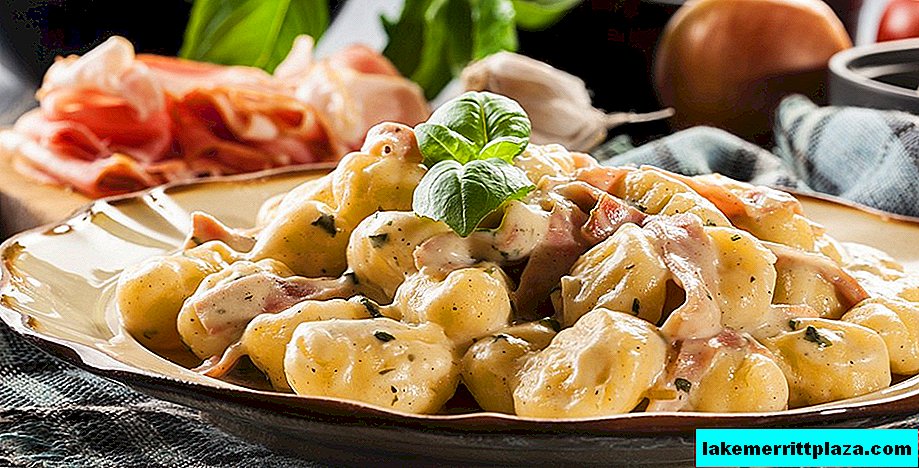
Grind onions and fry until golden brown in olive oil. Dice zucchini and combine with onion. Fry until cooked. Transfer the vegetables into the thicket of the blender and grind. Salt and pepper to taste.
Finely chop the mint leaves. To serve, mix the prepared gnocchi with zucchini cream, sprinkle with grated cheese and mint.
Spinach
Spinach sauce is simple, but at the same time healthy and light. It combines very well with potato gnocchi for a casual table.
Components:
- Frozen spinach - 200 g;
- Milk - 50 ml;
- Onion - half the head;
- Cream Cheese (Hohland) - 3 slices;
- Butter - 1 tbsp. spoon;
- Olive oil for frying;
- Hard cheese to taste.
To start, chop finely the onions and fry in olive oil until golden brown. Add a small amount of water and frozen spinach to the pan. Stew until the greens soften. In a blender, beat still hot onions with spinach, milk, cream cheese and butter. Mix the prepared gnocchi with the sauce and sprinkle with hard cheese to taste.
With fresh pepper
Fans of more savory dishes will appreciate fresh pepper sauce. To prepare it you will need:
- Bulgarian pepper - 2 pcs.;
- Garlic - 1 clove;
- Tomatoes - 500 g;
- Olive oil - 4 tbsp. spoons;
- Onion - 1 pc.;
- Bacon - 50 g;
- Wine - 200 ml;
- Parsley - a small bunch;
- Salt and black pepper to taste.
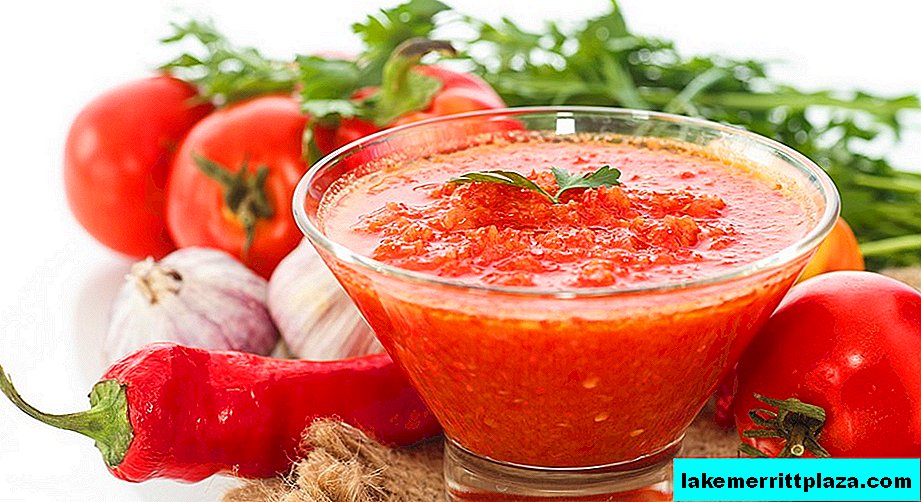
To make the sauce not only tasty, but also beautiful, we recommend taking peppers of different colors (yellow and red).
We clear the pepper from the seeds and cut into small cubes. Fry with garlic in olive oil over medium heat. Then add salt, black pepper, chopped parsley and 0.5 cups of water. Stew until the peppers are cooked.
In another pan, fry finely chopped onions with bacon in olive oil. Then pour the wine, add peeled and diced tomatoes. Salt, pepper to taste and simmer for about 40 minutes. At the very end, add the prepared pepper, mix and turn off the heat.
Combine the hot sauce with gnocchi and serve. If desired, the dish can be seasoned with allspice and chopped parsley.
Calorie content and composition
Contrary to the frightening word “potato” as part of classical gnocchi, their caloric content is relatively small. For example, it is lower than rice and pasta. Their nutritional value is only 124 kcal per 100 g and consists of:
- Proteins - 2.8 g;
- Fats - 2.8 g;
- Carbohydrates - 23.1 g.
In terms of use, salt dumplings do not stand out from other products. Therefore, there are no special warnings for hypertensive patients. Moreover, the homemade dish is easily adjusted for the amount of sodium chloride.

It is worth remembering that the caloric value of food is increased by the addition of sauces. Potato gnocchi, lightly seasoned with olive oil and tomato sauce, are ideal for any diet. Including for people with overweight, hypertension and high cholesterol.
Those suffering from type II diabetes mellitus should reduce portions of gnocchi due to their high glycemic index. In this case, an excellent option for serving dishes is with vegetable sauces and fresh vegetables.
A trip around the world of Italian dumplings has ended. We hope that now in your arsenal there is a wide scope for the embodiment of your culinary fantasies. Live diverse, cook for everyone and remember: "Lunch is thin when there are no gnocchi!"


